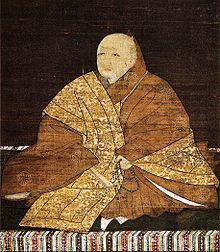
Back أشيكاغا يوشي-ميتسو Arabic Ashikaga Yoshimitsu Catalan Ashikaga Yoshimitsu German Ashikaga Yoshimitsu Spanish Ashikaga Yoshimitsu Basque آشیکاگا یوشیمیتسو Persian Ashikaga Yoshimitsu Finnish Ashikaga Yoshimitsu French Ashikaga Yoshimitsu HAK Ashikaga Yoshimitsu ID
Ashikaga Yoshimitsu 足利 義満 | |
|---|---|
 | |
| Shōgun | |
| In office 1368–1394 | |
| Monarchs | |
| Preceded by | Ashikaga Yoshiakira |
| Succeeded by | Ashikaga Yoshimochi |
| Personal details | |
| Born | September 25, 1358 |
| Died | May 31, 1408 (aged 49) |
| Spouses |
Among others... |
| Children | |
| Parents | |
| Signature |  |

Ashikaga Yoshimitsu (足利 義満, September 25, 1358 – May 31, 1408) was the third shōgun of the Ashikaga shogunate, ruling from 1368 to 1394 during the Muromachi period of Japan. Yoshimitsu was Ashikaga Yoshiakira's third son but the oldest son to survive, his childhood name being Haruō (春王). Yoshimitsu was appointed shōgun, a hereditary title as head of the military estate, in 1368 at the age of ten; at twenty he was admitted to the imperial court as Acting Grand Counselor (Gon Dainagon 権大納言).
In 1379, Yoshimitsu reorganized the institutional framework of the Gozan Zen 五山禅 establishment before, two years later, becoming the first person of the warrior (samurai) class to host a reigning emperor at his private residence. In 1392, he negotiated the end of the Nanboku-chō imperial schism that had plagued politics for over half a century. Two years later he became Grand Chancellor of State (Daijō daijin 太政大臣), the highest-ranking member of the imperial court.
Retiring from that and all public offices in 1395, Yoshimitsu took the tonsure and moved into his Kitayama-dono (北山殿) retirement villa which, among other things, boasted a pavilion two-thirds covered in gold leaf (Kinkaku shariden 金閣舎利殿). There, he received envoys from the Ming and Joseon courts on at least six occasions and forged the terms of a Sino-Japanese trade agreement that endured for over a century. In recognition for his diplomatic efforts (and overt displays of subservience), the Chinese sovereign pronounced Yoshimitsu "King of Japan" (Nihon kokuō 日本国王).
In 1407, he set into motion a plan to become "Daijō tenno" (太上天皇), a title customarily applied to a retired emperor. Although unrealized due to his sudden death the following year, this last venture was particularly audacious because Yoshimitsu never actually sat on the Japanese throne.[1] Late in his career, it appears Yoshimitsu sought to legitimize his transcendent authority through the idiom of Buddhist kingship, deploying ritual, symbols, and monumentalism to cast him as a universal monarch or dharma king, not unlike his counterparts in Southeast Asia.[2] His posthumous name was Rokuon'in (鹿苑院).
- ^ Stavros, Matthew, and Norika Kurioka. "Imperial Progress to the Muromachi Palace, 1381 A Study and Annotated Translation of Sakayuku Hana". Japan Review 28 (2015): 3–46. https://www.jstor.org/stable/43684115
- ^ Stavros, Matthew (December 2017). "Monuments and Mandalas in Medieval Kyoto: Reading Buddhist Kingship in the Urban Plan of Ashikaga Yoshimitsu". Harvard Journal of Asiatic Studies. 77 (2): 321–361. doi:10.1353/jas.2017.0029. S2CID 194880921 – via Project Muse.
© MMXXIII Rich X Search. We shall prevail. All rights reserved. Rich X Search